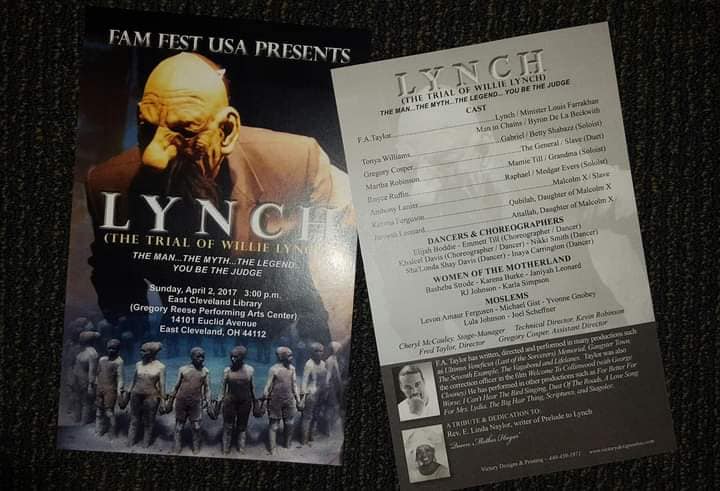By Anthony Byrd
On June 10, the East Cleveland Library hosted an engaging pre-Juneteenth extravaganza, offering a diverse range of pop-up shops and family-friendly activities. Among the standout events was a captivating theatrical production called Lynch: The Trial of Willie Lynch. Given Willie Lynch’s significant association with the history of slavery, it was instantly intriguing.
 The Trial of Willie Lynch, directed by Fred A. Taylor, was an engrossing and thought-provoking theatrical production that skillfully delved into the depths of historical injustice and its enduring impact on society. Lynch, widely known for his letter-implementing tactics to pit Black people against one another and to destroy the mental health of an entire community, was the focal point of the play. With its poignant and incisive voice, the production invited the audience to confront the brutal legacy of slavery, igniting a compelling exploration of the ongoing consequences that reverberate even today.
The Trial of Willie Lynch, directed by Fred A. Taylor, was an engrossing and thought-provoking theatrical production that skillfully delved into the depths of historical injustice and its enduring impact on society. Lynch, widely known for his letter-implementing tactics to pit Black people against one another and to destroy the mental health of an entire community, was the focal point of the play. With its poignant and incisive voice, the production invited the audience to confront the brutal legacy of slavery, igniting a compelling exploration of the ongoing consequences that reverberate even today.
The production’s greatest strength lay in its ability to seamlessly merge historical facts with a fictional courtroom drama. Set within the framework of a fictitious trial, the play centered around Willie Lynch, a symbolic character representative of the systemic oppression during the era of slavery. Through this metaphorical platform, the play bravely exposed the enduring repercussions of racism and discrimination in our collective history.
 A favorite feature of this play was Taylor’s use of contemporary dance performances, choreographed by Elijah Boddie, to complement and enhance the themes being explored in the script. This creative decision added an extra layer of depth and emotion to the production, elevating it beyond traditional theatrical conventions. This allowed the actors to convey their emotions and experiences through a different form of artistic expression. Taylor effectively bridged the gap between the past and present, further immersing the audience in the narrative. The synergy between the actors’ dialogue and the accompanying dance sequences created a multi-dimensional experience, engaging both the intellect and the senses.
A favorite feature of this play was Taylor’s use of contemporary dance performances, choreographed by Elijah Boddie, to complement and enhance the themes being explored in the script. This creative decision added an extra layer of depth and emotion to the production, elevating it beyond traditional theatrical conventions. This allowed the actors to convey their emotions and experiences through a different form of artistic expression. Taylor effectively bridged the gap between the past and present, further immersing the audience in the narrative. The synergy between the actors’ dialogue and the accompanying dance sequences created a multi-dimensional experience, engaging both the intellect and the senses.

 The Trial of Willie Lynch boasted an exceptional ensemble cast, with each member delivering performances that were emotionally charged and profoundly compelling. Each character, like Royce Ruffer as Medgar Evers, Martha Robinson as Mamie Till, and Laprise Marie Johnson as Betty Shabazz, represented a distinct era and carried with them a unique understanding of the weight of history. Their performances symbolized the ongoing fight for justice and equality, carrying the torch of change into the future. Their chemistry on stage created palpable energy, while their monologues and exchanges evoked a potent mix of anger, empathy, and introspection.
The Trial of Willie Lynch boasted an exceptional ensemble cast, with each member delivering performances that were emotionally charged and profoundly compelling. Each character, like Royce Ruffer as Medgar Evers, Martha Robinson as Mamie Till, and Laprise Marie Johnson as Betty Shabazz, represented a distinct era and carried with them a unique understanding of the weight of history. Their performances symbolized the ongoing fight for justice and equality, carrying the torch of change into the future. Their chemistry on stage created palpable energy, while their monologues and exchanges evoked a potent mix of anger, empathy, and introspection.
Complementing these performances, the play’s set design and staging were a testament to effective simplicity. The skillful use of lighting and sound design further enhanced the atmosphere, fostering a sense of tension, and amplifying dramatic moments throughout the play.
While The Trial of Willie Lynch excelled in many aspects, one area that could have benefited from further development was its pacing. Though the overall narrative flow was engaging, there were occasional instances where certain scenes felt slightly drawn out, causing a dip in the play’s momentum. By offering glimpses of hope and actionable change, Taylor’s presentation would have provided a more well-rounded and impactful narrative.
With its exceptional performances, thought-provoking narrative, and commitment to fostering crucial conversations, The Trial of Willie Lynch was an important and necessary production. The portrayals served as a reminder of the enduring legacy of oppression and the importance of passing down knowledge and stories to younger generations. This play, which Taylor attempts to produce annually, left a lasting impression and serves as a catalyst for meaningful change.
Additional reporting editing team






